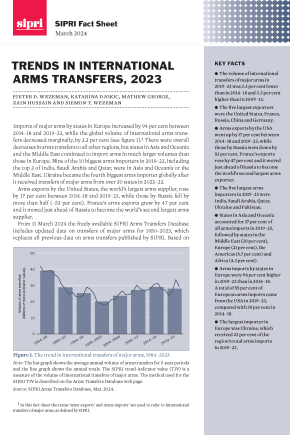Trends in International Arms Transfers, 2023

Imports of major arms by states in Europe increased by 94 per cent between 2014–18 and 2019–23, while the global volume of international arms transfers decreased marginally, by 3.3 per cent. There were overall decreases in arms transfers to all other regions, but states in Asia and Oceania and the Middle East continued to import arms in much larger volumes than those in Europe. Nine of the 10 biggest arms importers in 2019–23, including the top 3 of India, Saudi Arabia and Qatar, were in Asia and Oceania or the Middle East. Ukraine became the fourth biggest arms importer globally after it received transfers of major arms from over 30 states in 2022–23.
Arms exports by the United States, the world’s largest arms supplier, rose by 17 per cent between 2014–18 and 2019–23, while those by Russia fell by more than half (–53 per cent). France’s arms exports grew by 47 per cent and it moved just ahead of Russia to become the world’s second largest arms supplier.
From 11 March 2024 the freely available SIPRI Arms Transfers Database includes updated data on transfers of major arms for 1950–2023, which replaces all previous data on arms transfers published by SIPRI. Based on the new data, this fact sheet presents global trends in arms exports and arms imports, and highlights selected issues related to transfers of major arms.
ABOUT THE AUTHOR(S)/EDITORS
When peace is under threat, accurate information is more important than ever.
Invest in the facts




